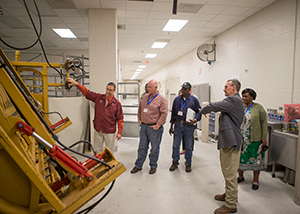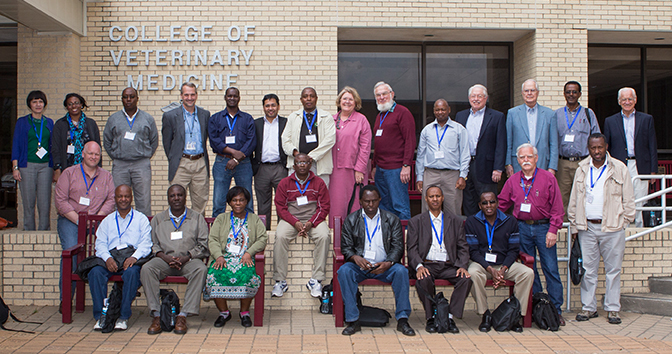East African Veterinarians Visit Texas A&M College of Veterinary Medicine & Biomedical Sciences
COLLEGE STATION, TX – Devastating disease outbreaks among livestock in the United States are relatively rare and can generally be rapidly contained, when they do occur. However, in the countries of East Africa, livestock disease outbreaks are common. Like our fifty states, the countries of East Africa are separate entities that nevertheless have a lot of interstate movement-of both people and animals. They currently lack a unifying system of animal disease prevention and control. Furthermore, when diseases do occur in East Africa, the results can be devastating to livestock producers. Cooperative, safe, and stable livestock trade would lead to improved incomes, economic stability, and therefore a better quality of life for many in the region.

Therefore, veterinary leaders from many of these countries-with help from the United States Department of Agriculture and the USAID (United States Agency for International Development), are working to create a Standard Methods and Procedures in Animal Health (SMP-AH) that may then be implemented in East African nations.
As part of this effort, Chief Veterinary Officers (CVO), epidemiologists, and other leaders from six countries in East Africa (Kenya, Ethiopia, South Sudan, Tanzania, Djibouti, and Uganda), who collectively share oversight for more than 300 million animals, recently spent two weeks in the United States, with a week in Oregon and Washington state and a week in Texas-during which the group visited the Texas A&M College of Veterinary Medicine & Biomedical Sciences (CVM).
“The CVM is taking a lead role in the One Health Plus Initiative, the recognition that animal, human, and ecosystem health are all inextricably linked,” said Dr. Eleanor Green, Carl B. King Dean of Veterinary Medicine. “It is through collaborative projects such as this that we are able to build a global partnership that improves the quality of life for people and animals in other parts of the world.”
The visit, hosted by both the Norman Borlaug Institute for
International Agriculture at the Texas A&M College of Agriculture & Life Sciences and the CVM, included a welcome from Dean Green, a tour of the facilities-including the large and small animal hospitals and the necropsy facility-and lectures by several CVM and AgriLife faculty members. The group then spent the afternoon visiting the Texas Veterinary Medical Diagnostic Laboratory and the National Center for Foreign Animal and Zoonotic Disease Defense (FAZD Center) before boarding a bus to Austin.
“We’re showing them how the US manages disease control in livestock in a wide variety of ecosystems,” said Jeff Austin of USAID-East Africa, on large ranches and small ones. Members of the CVM faculty helped with hosting the delegation from Africa. Guy Shepherd, Director of Development; Dan Posey, Director of Special Programs and Clinical Associate Professor; and Clay Ashley, Director of Veterinary Medical Park, led the tours of the CVM complex and answered questions about the practice of veterinary medicine in the United States. Dr. Kenita Rogers, Associate Dean for Professional Programs provided an overview of the CVM veterinary curriculum; Dr. Michael Chaddock, Assistant Dean for One Health and Strategic Initiatives, lectured about the One Health Initiative; Dr. Jason Cleere, Associate Professor in the Department of Animal Science in the College of Agriculture & Life Sciences and Extension Beef Cattle Specialist, spoke about the Texas beef industry and the effects of drought; and Dr. Thomas Craig, Professor in the Department of Veterinary Pathobiology (VTPB) at the CVM, discussed parasite management in small ruminants.


“There are so many resources at Texas A&M we can take advantage of,” said James Wabacha, SMP-AH Manager, African Union – Interafrican Bureau for Animal Resources. “I really enjoyed going through the clinics-they’re such great facilities. I have taken photos to share with other faculty members in my country.”
Creating standard methods has to be a bottom-up approach, several people noted, that the producers themselves understand and support, rather than regulations imposed from the top-down by the United States-or any other country. Furthermore, simply taking our procedures and using them in Africa wouldn’t work, because their needs-and the diseases-are different, said Andrew Clark of USAID-East Africa.
“You have Africanize [the control methods] to match the diseases,” Clark said.
Several of the visiting veterinarians mentioned the need for partnerships between their countries and the United States.
“I expect some relationships to develop,” said Nicholas Kauta, CVO of Uganda. He, and several other CVOs, mentioned that one of the most useful parts of the trip for them was the opportunity to meet veterinarians and researchers who might later be a source of help and advice.
Peter Ithondeka, CVO of Kenya, noted that Texas is a perfect place to study procedures because it has similar weather as much of East Africa.
“We can take the good things here,” said Bewket Siraw, CVO of Ethiopia, “and bring change in our own environments.” Even when they can’t apply them directly, the methods used in the United States can then be adapted, he said.
“We have found many things we want to take back to our own countries,” said Kauta.
“One of the goals of this trip is to provide the East African CVOs with knowledge and experiences that they can adapt to benefit their entire region,” said Dr. Linda Logan, Professor and Head of VTPB at the CVM and one of the organizers of the visit. “Livestock production is a key to food security in East Africa. Developing a system to promote safe livestock trade was the objective of the program. Although many had been to the United States before, this was the first time many of the CVOs had seen livestock production methods first hand.”


